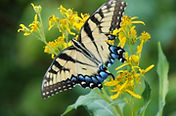monarch (Danaus plexippus)
CONFIRMATION STATUS: Confirmed.
FAMILY: Brush-footed Butterflies (Nymphalidae)
SUBFAMILY: Milkweed Butterflies (Danainae)
IDENTIFICATION: Upperside of male is bright orange with wide black
borders and black veins; hindwing has a patch of scent scales. Upperside
of female is orange-brown with wide black borders and blurred black
veins. Both sexes have white spots on borders and apex. The Viceroy
butterfly (Limenitis archippus) is a Mullerian mimic; it has similar
coloration and is also distasteful.
LIFE HISTORY: Adults warm up by basking dorsally (with their wings
open and toward the sun). Females lay eggs singly under the host leaves;
caterpillars eat leaves and flowers. Adults make massive migrations from
August-October, flying thousands of miles south to hibernate along the
California coast and in central Mexico. A few overwinter along the Gulf
coast or south Atlantic coast. Along the way, Monarchs stop to feed on
flower nectar and to roost together at night. At the Mexico wintering
sites, butterflies roost in trees and form huge aggregations that may
have millions of individuals. During the winter the butterflies may take
moisture and flower nectar during warm days. Most have mated before
they leave for the north in the spring, and females lay eggs along the way.
Residents of tropical areas do not migrate but appear to make altitude
changes during the dry season.
FLIGHT: In North America during spring and summer there may be 1-3
broods in the north and 4-6 broods in the south. May breed all year in
Florida, South Texas, and southeastern California.
WING SPAN: 3 3/8 - 4 7/8 inches (8.6 - 12.4 cm).
CATERPILLAR HOSTS: Milkweeds including common milkweed
(Asclepias syriaca), swamp milkweed (Asclepias incarnata), and showy
milkweed (Asclepias speciosa); and milkweed vine in the tropics. Most
milkweeds contain cardiac glycosides which are stored in the bodies of
both the caterpillar and adult. These poisons are distasteful and emetic to
birds and other vertebrate predators. After tasting a Monarch, a predator
might associate the bright warning colors of the adult or caterpillar with
an unpleasant meal, and avoid Monarchs in the future.
ADULT FOOD: Nectar from all milkweeds. Early in the season before
milkweeds bloom, Monarchs visit a variety of flowers including dogbane,
lilac, red clover, lantana, and thistles. In the fall adults visit composites
including goldenrods, blazing stars, ironweed, and tickseed sunflower.
HABITAT: Many open habitats including fields, meadows, weedy areas,
marshes, and roadsides.
RANGE: Southern Canada south through all of the United States, Central
America, and most of South America. Also present in Australia, Hawaii,
and other Pacific Islands.
CONSERVATION: Overwintering sites in California and Mexico should be
protected and conserved.
NATURESERVE GLOBAL STATUS: G5 - Demonstrably secure globally,
though it may be quite rare in parts of its range, especially at the
periphery.
MANAGEMENT NEEDS: Develop conservation and management plans for
all wintering sites, migration corridors, and principal breeding areas.
SKY MEADOWS OCCURRENCE:
Note: Due to seasonal conditions in this region, occurrence may vary from
year to year. The designation of occurrence may range over two or more
categories and may vary even during a single season.
Key to Checklist
A Abundant: Easy to see very large numbers of individuals in appropriate habitat
at proper time of year.
C Common: Usually each to see good numbers of individuals in appropriate habitat
at proper time of year.
U Uncommon: Sometimes found in appropriate habitat and proper time of year,
usually in low numbers.
O Occasional: Found in appropriate habitat perhaps only a few times a year, usually
in low numbers.
R Rare: Small chance of being found, even in appropriate habitat at proper time of
year. There are few individuals and may not be present every year.
X Extirpated: Formerly present, no longer occurs in Sky Meadows Park.
January
February
March
April
May
June
July
August
September
October
November
December

Park Activities
Calendar of Events
Volunteer Programs
Sky Meadows Park
Location
Geography
Habitats
Trails
Visiting Park
Crooked Run Valley
Special Projects

